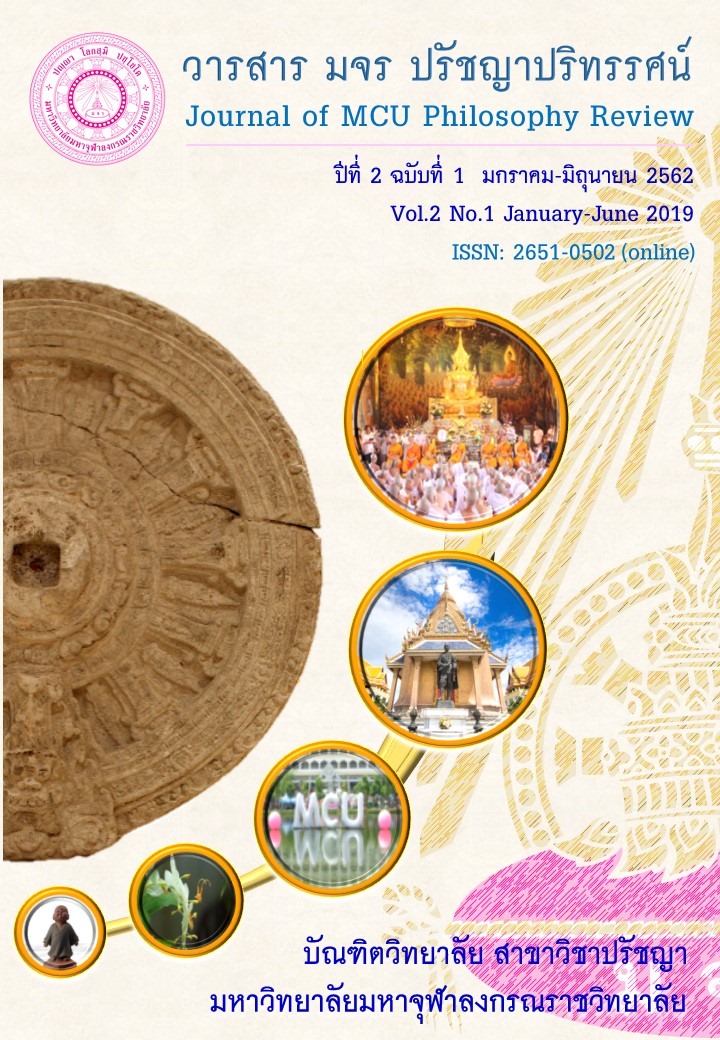Existence of Evil in Buddhist Philosophical Perspective
Main Article Content
Abstract
The title of academic article is “Evil’s Being in Theravada philosophy”. It is the study through Theravada texts in the point of basic problem of evil’s being in Theravada philosophy. The evil in Theravada philosophy is classified in 2 levels: 1) Kammaniyama means the evil’s being in the law of Kamma(Action) and 2) Chitaniyama means the evil’s being in the feeing of person who has done evil. The evil is the results of action which is the root from unwholesome. It has 3 components: 1) Kilesa (defilement) 2)Kamma (Action) and 3)Vipaka (the results). They are the roots of evil in Theravada philosophy. The justice law of the evil’s being in Theravada philosophy proves that the evil is reality. Theravada philosophy believes that who ace bad thing, will get bad thing in the hell. “Hell” means the place for bad person. The results of bad action are complex. Because it is condition about “time” “duty” and “strong and weak”. Some is quick but some is slow. Some is this life and some in the next life. The confirmative conclusion of the point is the evil’s being in Theravada philosophy is real.
Article Details
บทความที่ได้รับการตีพิมพ์เป็นลิขสิทธิ์ของวารสาร มจร ปรัชญาปริทรรศน์
ข้อความในบทความที่ได้รับการตีพิมพ์ในวารสาร ถือเป็นความรับผิดชอบของผู้เขียนบทความ และข้อคิดเห็นนั้นไม่ถือว่าเป็นทัศนะและความรับผิดชอบของกองบรรณาธิการวารสาร มจร ปรัชญาปริทรรศน์
References
พระเจ้าบรมวงศ์เธอกรมพระจันทบุรีนฤนาท. (2553). ปทานุกรมบาลี -ไทย -อังกฤษ –สังสกฤต. พิมพ์ครั้งที่ 5. นครปฐม : โรงพิมพ์มหามกุฎราชวิทยาลัย.
พระธรรมปิฎก (ป.อ. ปยุตฺโต). (2543). พจนานุกรมพุทธศาสตร์ฉบับประมวลธรรม. กรุงเทพมหานคร : มหาจุฬาลงกรณราชวิทยาลัย.
พระธรรมปิฎก (ป.อ. ปยุตฺโต). (2554). พจนานุกรมพุทธศาสน์ ฉบับประมวลศัพท์. กรุงเทพมหานคร: โรงพิมพ์พระพุทธศาสนาของธรรมสภา.
มหาจุฬาลงกรณราชวิทยาลัย. (2539). พระไตรปิฎกภาษาไทย. ฉบับมหาจุฬาลงกรณราชวิทยาลัย. กรุงเทพมหานคร : โรงพิมพ์มหาจุฬาลงกรณราชวิทยาลัย.
มหาจุฬาลงกรณราชวิทยาลัย (2560).อรรถกถาภาษาไทย ฉบับมหาจุฬาลงกรณราชวิทยาลัย.กรุงเทพมหานคร: โรงพิมพ์มหาจุฬาลงกรณราชวิทยาลัย.
มหามกุฏราชวิทยาลัย. (2531). พระธรรมปทัฏฐกถาแปล ภาค 1. กรุงเทพมหานคร: มหามกุฏราชวิทยาลัย.
ราชบัณฑิตยสถาน. (2546). พจนานุกรมฉบับราชบัณฑิตยสถาน พ.ศ. 2542. กรุงเทพมหานคร : บริษัทนานมีบุ๊คส์พับลิเคชันส์ จำกัด.
วัชระ งามจิตรเจริญ. (2550). พุทธศาสนาเถรวาท. กรุงเทพมหานคร: มหาวิทยาลัยธรรมศาสตร์.
สมภาร พรมทา. (2546). พุทธศาสนานิกายเซน การศึกษาเชิงวิเคราะห์. กรุงเทพมหานคร: สำนักพิมพ์แห่งจุฬาลงกรณ์มหาวิทยาลัย.
สมภาร พรมทา. (2540). พุทธศาสนากับวิทยาศาสตร์. กรุงเทพมหานคร: จุฬาลงกรณ์มหาวิทยาลัย.
สมัคร บุราวาส. (2555). จิตวิทยาและการทำใจทางพระพุทธศาสนา. กรุงเทพมหานคร: สำนักพิมพ์ศยาม.
เสถียรพงษ์ วรรณปก. (2537). พุทธศาสนา: ทรรศนะและวิจารณ์. กรุงเทพมหานคร: สำนักพิมพ์มติชน.
แสง จันทร์งาม. (2544). พุทธศาสนวิทยา. กรุงเทพมหานคร : ธีระการพิมพ์.
อดิศักดิ์ ทองบุญ. (2533). คู่มืออภิปรัชญา. กรุงเทพมหานคร : พิมพ์ที่ โรงพิมพ์มหาจุฬาลงกรณราชวิทยาลัย.


